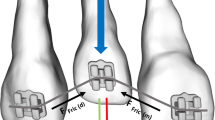Abstract
Aim: The aim of the present study was to investigate slot deformation and the equivalent torque capacity of plastic brackets in comparison with those of a metal bracket in vitro and to simulate them under clinical conditions.
Material and Method: For this purpose the expansion characteristics of the brackets and their resistance to extraoral mechanical loading were compared in in-vitro activating experiments. In a further investigation, the labial crown torque of an upper central incisor was measured in a simulated intraoral clinical siutation, using the Orthodontic Measuring and Simulation System (OMSS). Four types of bracket manufactured by Forestadent®, Pforzheim, Germany, were tested: the plastic brackets Aesthetik-Line® and Brillant®, the latter from a previous series (Brillant®-old) and from a modified series (Brillant®-new), and the metal bracket MINI-MONO®. For testing purposes the brackets were torqued with 0.016"×0.022" (0.41×0.56 mm) and 0.018"×0.022" (0.46×0.56 mm) ideal steel archwires (Remanium®, Dentaurum, Ispringen, Germany).
Results: In the activating experiments, significantly higher torque losses and lower torquing moments were registered with both rectangular archwires with the plastic brackets than with the metal bracket. In the simulation tests, significantly higher torquing moments were registered with the metal bracket than with the plastic brackets. The OMSS model approximates the clinical situation, with the torque loss being notably higher than in the in-vitro activating experiments. This is due to the adjacent teeth giving the archwire additional play. In addition, the torquing process of the rectangular wire may deform the archwire, resulting in subsidiary forces.
Conclusion: On the basis of the present results, the Brillant® and Aesthetik-Line® plastic brackets and the MINI-MONO® metal bracket can be recommended for torquing. In view of the high torque losses, however, the torques programmed in the straight wire technique must be seen as questionable. It would be helpful to the practitioner if data were provided by the manufacturer on the flexing to be expected in plastic brackets, which has to be offset by additional torque or the possible renunciation of bracket torque.
Zusammenfassung
Ziel: Ziel der Arbeit war es, die Verformung der Slots sowie das entsprechende Torquevermögen von Kunststoffbrackets im Vergleich zu einem Metallbracket in vitro zu untersuchen und klinisch zu simulieren.
Material und Methode: Es wurde bei In-vitro-Aktivierungsversuchen das Aufdehnungsverhalten bzw. das mechanische Belastungsvermögen der Brackets außerhalb der Zahnreihe gegenübergestellt. In einer weiteren Untersuchung wurde mit dem Orthodontischen Mess- und Simulations-System (OMSS) der vestibuläre Kronentorque eines oberen mitteren Schneidezahnes innerhalb der Zahnreihe durchgeführt und damit die klinische Situation simuliert. Es wurden insgesamt vier Bracketarten der Firma Forestadent®, Pforzheim, getestet: die Kunststoffbrackets Aesthetik-Line® und Brillant® sowie das Metallbracket MINI-MONO®. Von den Brillant®-Brackets wurden eine frühere Serie (Brillant®-alt) und eine überarbeitete Serie (Brillant®-neu) getestet. Die Brackets wurden in den Versuchen mit 0,016"×0,022"-(0,41×0,56 mm-) und 0,018"×0,022%-(0,46&6imes;0,56 mm)Stahlidealbögen (Remanium®, Dentaurum, Ispringen) getorquet.
Ergebnisse: In den Aktivierungsversuchen erreichten die Kunststoffbrackets mit beiden Vierkantdrähten signifikant höhere Torqueverluste und geringere Torquemomente als die Metallbrackets. In den Simulationsversuchen erreichten die Metallbrackets wiederum signifikant höhere Torquemomente als die Kunststoffbrackets. Das Modell des OMSS kommt der klinischen Situation sehr nahe. Dort liegt der Torqueverlust deutlich höher als bei den In-vitro-Aktivierungsversuchen. Dies ist darin begründet, dass die Nachbarzähne ein zusätzliches Spiel des Vierkantbogens zulassen. Außerdem kommt es bei der Verwindung des Vierkantbogens zu Bogendeformationen, die zur Entstehung von Nebenkräften führen.
Schlussfolgerung: Aufgrund der vorliegenden Ergebnisse können die Kunststoffbrackets Brillant® und Aesthetik-Line® ebenso wie die Metallbrackets MINI-MONO® zum Torque empfohlen werden. Vor dem Hintergrund der hohen Torqueverluste sind die in der Straightwire-Technik programmierten Torquewerte aber als fraglich einzuschätzen. Eine Herstellerangabe über die zu erwartende Aufbiegung bei den Kunststoffbrackets, die durch einen zusätzlichen Torque bzw. einen Verzicht auf einen Torque im Bracket kompensiert werden muss, wäre für den Praktiker hilfreich.
Similar content being viewed by others
Author information
Authors and Affiliations
Additional information
Received: December 4, 2000; accepted: October 16, 2001
Rights and permissions
About this article
Cite this article
Gmyrek, H., Bourauel, C., Richter, G. et al. Torque Capacity of Metal and Plastic Brackets with Reference to Materials, Application, Technology and Biomechanics. Journal of Orofacial Orthopedics / Fortschritte der Kieferorthopädie 63, 113–128 (2002). https://doi.org/10.1007/s00056-002-0065-x
Published:
Issue Date:
DOI: https://doi.org/10.1007/s00056-002-0065-x




